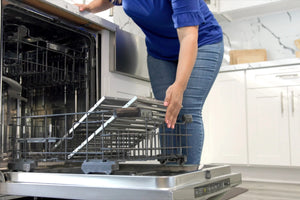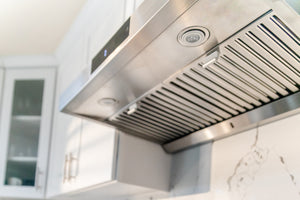How to Load a Dishwasher
Like the range hood, a dishwasher is another one of those magical kitchen appliances that we learn to love growing into adulthood. Both appliances serve as impressive time-saving devices when it comes to after cooking clean-up; the dishwasher effortlessly cleaning a week's worth of dirty dishes with the push of a button. However, if not operated properly, it can lead to frustration and damage, such as warped wood boards, dull knives, and the disappointing realization that many dishes remain unclean after the cycle completes.


But have you ever wondered what happens when you close the door and begin the cycle? To many a surprise, there is actually a set of guidelines that you can follow to make sure that your dishes come out sparkling clean, every time. Plus, these best practices can help save water and protect your kitchenware.
What Goes In the Dishwasher?
Although it’s tempting to save yourself from manually washing dishes, you shouldn’t place EVERY dish in the dishwasher. Make sure it’s dishwasher safe by looking for the label that is typically located at the bottom of the dish. The label could be text that says “dishwasher-safe”, or a symbol representing a dishwasher.
It is advised to keep sharp blades and knives out of the dishwasher to prevent them from dulling, or rusting over time. Skip adding the wooden utensils and cutting boards, which tend to crack and warp from the temperatures in the dishwasher. Opt to hand wash important pieces that are delicate, like wine glasses.
Lastly and unfortunately, most pans aren’t meant to be put in the dishwasher. The dishwasher will strip the pan of its non-stick coating and cause corrosion over time. The only pan that is safe to load into the dishwasher is a stainless steel pan. Similarly, Hauslane’s range hood baffle filters are made from high-quality stainless steel making them dishwasher safe as well!
How to Load a Dishwasher:
Load your dishwasher from back to front for optimal space. Use the dishwasher rack tines to keep dishes organized. It is best not to overcrowd the dishwasher to ensure that the water jets can reach each dish properly.
- Bottom rack: Use the bottom rack for large heavy items such as plates and large bowls.
- Top Rack: Use the top rack for lighter items like cups, mugs, small bowls, and range hood filters! Place them facing down or down and angled using the slanted rack area (if your dishwasher rack has one) so that the sprayers can reach inside to clean.
- Utensils: Place utensils facing up in the utensil basket in your dishwasher. Placing them with their handle up will clean only the handle. However, for safety, face any sharp knives down or save them for the sink.
What Happens When I Press Start?
Although it may vary throughout dishwasher models and brands, in the majority of contemporary dishwashers, the primary spray arm is positioned near the bottom, just above the heating element. This rotating arm disperses a blend of hot water and detergent, akin to a lawn sprinkler, effectively cleaning your dishes. To guarantee thorough cleaning, it's crucial to prevent bulky items from obstructing the spray jets. These larger items should be placed along the sides and positioned at an angle, as with cups, for a successful cleaning process.








